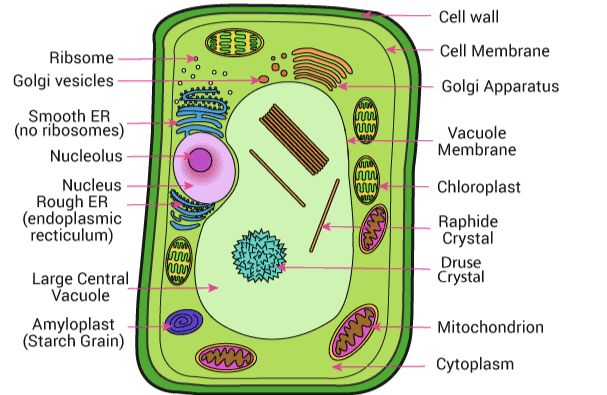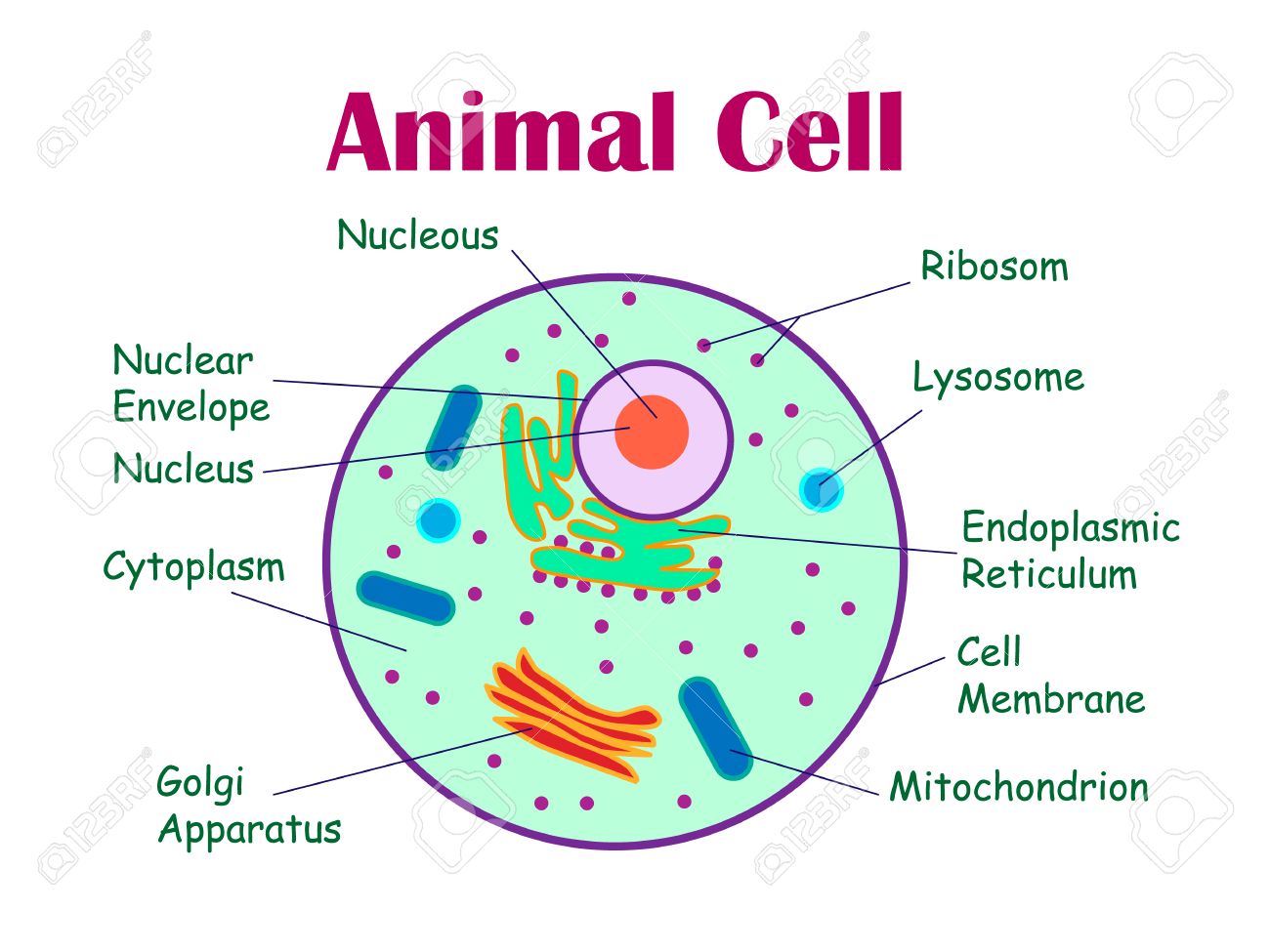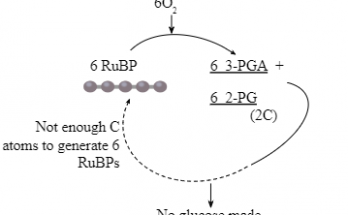Table of Contents
Plant Cell and Animal Cell
Plant Cells and Animal Cells are types of Eukaryotic Cells that share many similarities but also have some key differences. Plant Cells have a rigid Cell Wall, Chloroplasts and large central Vacuoles, while Animal Cells have a flexible cell membrane and smaller Vacuoles. Both types of cells contain many of the same organelles and are responsible for carrying out essential functions within living organisms.
Understanding these differences is crucial for understanding the structure and function of living organisms
Also Check – 9 Important Similarities between Plant and Animal Cell
There are some important differences between Plant and Animal Cells which are as follows-
16 Important Differences Between Plant Cell and Animal Cell
| Characteristic | Plant Cell | Animal Cell |
|---|---|---|
| Cell Wall | Present in addition to Plasma Membrane. It is outside the Plasma Membrane. | Absent |
| Shape | Generally regular in shape, often rectangular or square-shaped. | Generally irregular in shape. |
| Size | Larger in size than Animal Cells. | Smaller in size than Plant Cells. |
| Plastids | Present, which are organelles that perform various functions such as Photosynthesis. | Absent except for the euglena. |
| Vacuoles | Large, central Vacuole that occupies most of the cell’s volume. | Many small Vacuoles that are temporary and play a role in storage and transport. |
| Golgi Apparatus | Simple units of Golgi Apparatus. | Single highly complex and prominent Golgi Apparatus. |
| Centrioles | Absent, except for motile cells of lower plants. | Present. |
| Lysosomes | Rarely found. | Present. |
| Storage Material | Starch grains. | Glycogen granules. |
| Plasmodesmata | Channels that allow for communication and exchange of materials between adjacent cells. | Absent. |
| Glyoxysomes | Organelles that convert stored lipids into carbohydrates for energy during germination. | Absent. |
| Mitochondria | Present, responsible for producing energy in cells. | Present, generally more numerous than in Plant Cells. |
| Chloroplasts | Present, organelles that carry out Photosynthesis and responsible for the green colour of plants. | Absent. |
| Cytoskeleton | Made up of microtubules, microfilaments and intermediate filaments. Provides support and maintains cell shape. | Made up of microfilaments, microtubules and intermediate filaments. Provides support and aids in cell movement. |
| Endoplasmic Reticulum | Rough ER, involved in protein synthesis. Smooth ER, involved in lipid synthesis. | Rough ER, involved in protein synthesis. Smooth ER, involved in lipid synthesis. |
| Cilia | Absent. | Present, often used for movement or to move substances along the cell surface. |
| Mode of Nutrition | Autotrophic, synthesises its own food through photosynthesis. | Heterotrophic, obtains food from other sources. |
| Diagram |  |  |
Also Check – 9 Important Similarities between Plant and Animal cell
Differences Between Plant Cell and Animal Cell Explained in Details
- Difference Between Plant Cell and Animal Cell in terms of Cell Wall
Plant Cells have a rigid Cell Wall made of cellulose that provides structural support and protection for the cell, while Animal Cells do not have a Cell Wall. The Cell Wall is present in addition to the Plasma Membrane and is located outside of it. This additional layer provides added protection against physical damage and helps maintain the shape of the Plant Cell.
Also Check – 11 Difference between Cell Wall and Cell Membrane (Plasma Membrane)
- Difference Between Plant Cell and Animal Cell in terms of Shape
Plant Cells are generally regular in shape, often rectangular or square-shaped, while Animal Cells are generally irregular in shape. This difference in shape is due to the presence of the Cell Wall in Plant Cells that helps to maintain the shape of the cell.
- Difference Between Plant Cell and Animal Cell in terms of Size
Plant Cells are larger in size than Animal Cells. This is because Plant Cells have a larger central Vacuole that takes up most of the cell’s volume and also due to the presence of a Cell Wall.
Also Check – The Animal Cell Structure
- Difference Between Plant Cell and Animal Cell in terms of Plastids
Plastids are organelles that perform various functions such as Photosynthesis. They are present in Plant Cells but absent in Animal Cells, except for the euglena. Plastids are responsible for the green colour of Plant Cells due to the presence of Chlorophyll.
- Difference Between Plant Cell and Animal Cell in terms of Vacuoles
Plant Cells have a large, central Vacuole that occupies most of the cell’s volume, while Animal Cells have many small Vacuoles that are temporary and play a role in storage and transport. The central Vacuole in Plant Cells helps maintain turgor pressure that is important for the rigidity and shape of the plant.
- Difference Between Plant Cell and Animal Cell in terms of Golgi Apparatus
The Golgi Apparatus is an organelle responsible for processing and sorting proteins and lipids. Plant Cells have simple units of the Golgi Apparatus, while Animal Cells have a single highly complex and prominent Golgi Apparatus. The complex Golgi Apparatus in Animal Cells allows for more efficient processing and sorting of molecules that is important for cell function.
- Difference Between Plant Cell and Animal Cell in terms of Centrioles
Centrioles are cylindrical structures that play a crucial role in cell division and the formation of cilia and flagella. They are absent in Plant Cells, except for motile cells of lower plants, while they are present in Animal Cells.
Also Check – Mitosis In Plant Cell and Animal Cell- Differences and Similarities
- Difference Between Plant Cell and Animal Cell in terms of Lysosomes
Lysosomes are organelles that contain enzymes involved in the breakdown of cellular waste. They are rarely found in Plant Cells, while they are present in Animal Cells.
Storage Material Plant Cells store materials in starch grains, while Animal Cells store glycogen granules.
- Difference Between Plant Cell and Animal Cell in terms of Plasmodesmata
Plasmodesmata are channels that allow for communication and exchange of materials between adjacent cells. They are unique to Plant Cells and are absent in Animal Cells.
- Difference Between Plant Cell and Animal Cell in terms of Glyoxysomes
Glyoxysomes are organelles that are involved in the conversion of stored lipids into carbohydrates for energy during germination. They are present in Plant Cells, while Animal Cells do not have glyoxysomes.
- Difference Between Plant Cell and Animal Cell in terms of Mitochondria
Mitochondria are organelles responsible for producing energy in cells. They are present in both plant and Animal Cells, but they are generally more numerous in Animal Cells.
- Difference Between Plant Cell and Animal Cell in terms of Chloroplasts
Chloroplasts are organelles found in Plant Cells that carry out Photosynthesis, a process by which plants convert light energy into chemical energy. Chloroplasts are responsible for the green colour of plants. Animal Cells do not contain Chloroplasts.
- Difference Between Plant Cell and Animal Cell in terms of Cytoskeleton
Both plant and Animal Cells have a Cytoskeleton.It is a network of protein fibres that provides structural support and helps with cell movement. Plant Cells have a more rigid Cytoskeleton due to the presence of cellulose in the Cell Wall and Animal Cells have a more flexible Cytoskeleton made up of different types of proteins.
- Difference Between Plant Cell and Animal Cell in terms of Endoplasmic Reticulum
The Endoplasmic Reticulum (ER) is an organelle that is involved in the synthesis and transport of proteins and lipids. Both plant and Animal Cells have an ER, but Plant Cells have a more extensive and specialised ER system. In particular, Plant Cells have stacks of flattened membrane sacs called cisternae that are involved in the synthesis of various molecules, including the Cell Wall components.
- Difference Between Plant Cell and Animal Cell in terms of Cilia
Animal cells have cilia, which are short hair-like structures that protrude from the surface of the cell and are involved in movement or moving substances along the cell surface. Plant cells do not have cilia.
- Difference Between Plant Cell and Animal Cell in terms of Mode of Nutrition
Plant cells are autotrophic, which means they synthesise their own food through the process of photosynthesis. They use energy from the sun, carbon dioxide from the air, and water from the soil to produce glucose, which is their source of food. Animal cells are heterotrophic, which means they obtain their food from other sources. They consume other organisms or organic matter to obtain nutrients necessary for their survival.
Also Check – What are the Differences between Autotrophic Nutrition and Heterotrophic Nutrition?
Also Check – Difference Between Plant tissue And Animal Tissue
Also Check- What is the Difference between Plant Vacuoles and Animal Vacuoles?
Also Check – Parts of Plant Cell – Location , Structure and Functions
Also Check – 5 Important Difference between Plant Vacuoles and Animal Vacuoles


10 Comments on “16 Differences Between Plant Cell and Animal Cell”